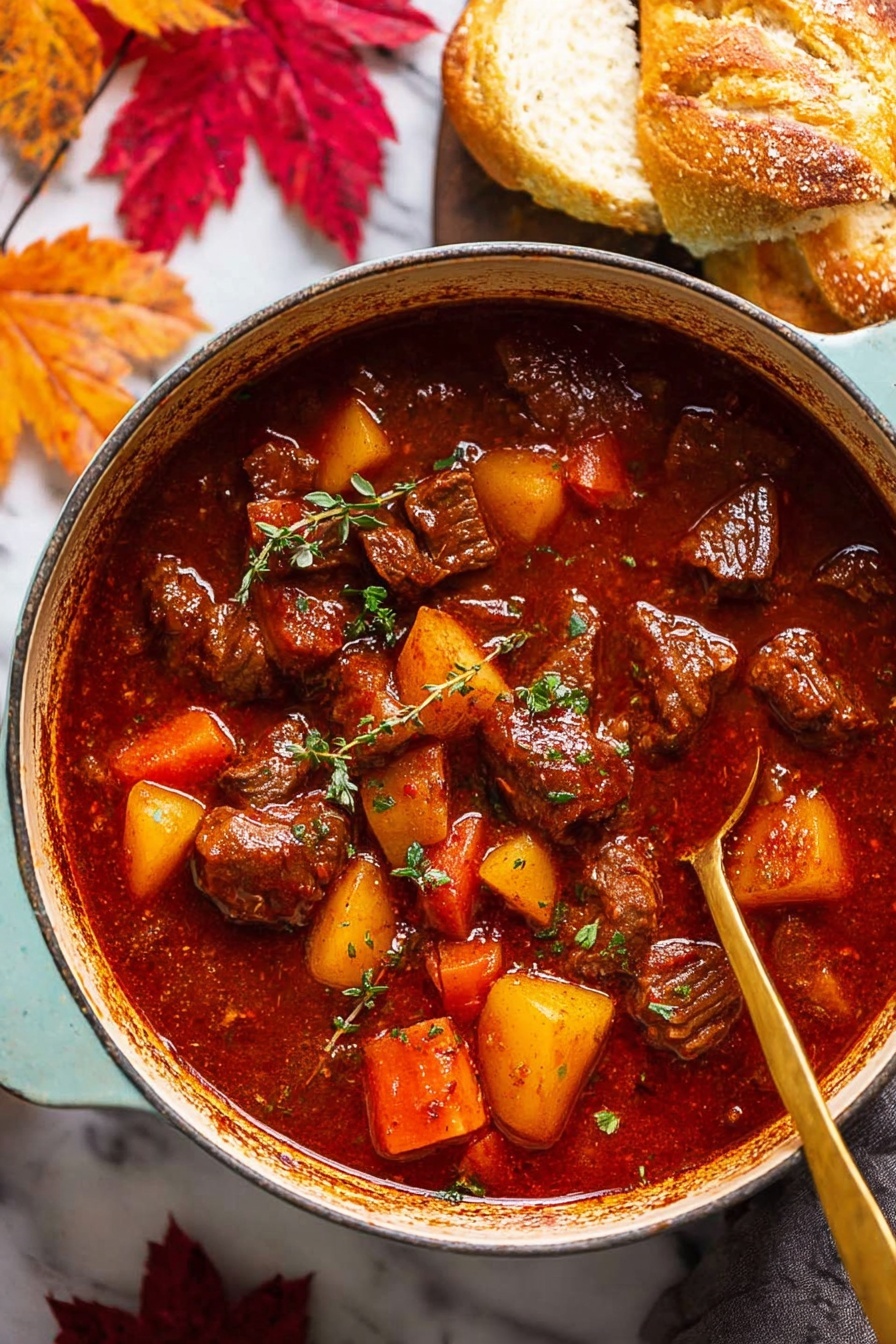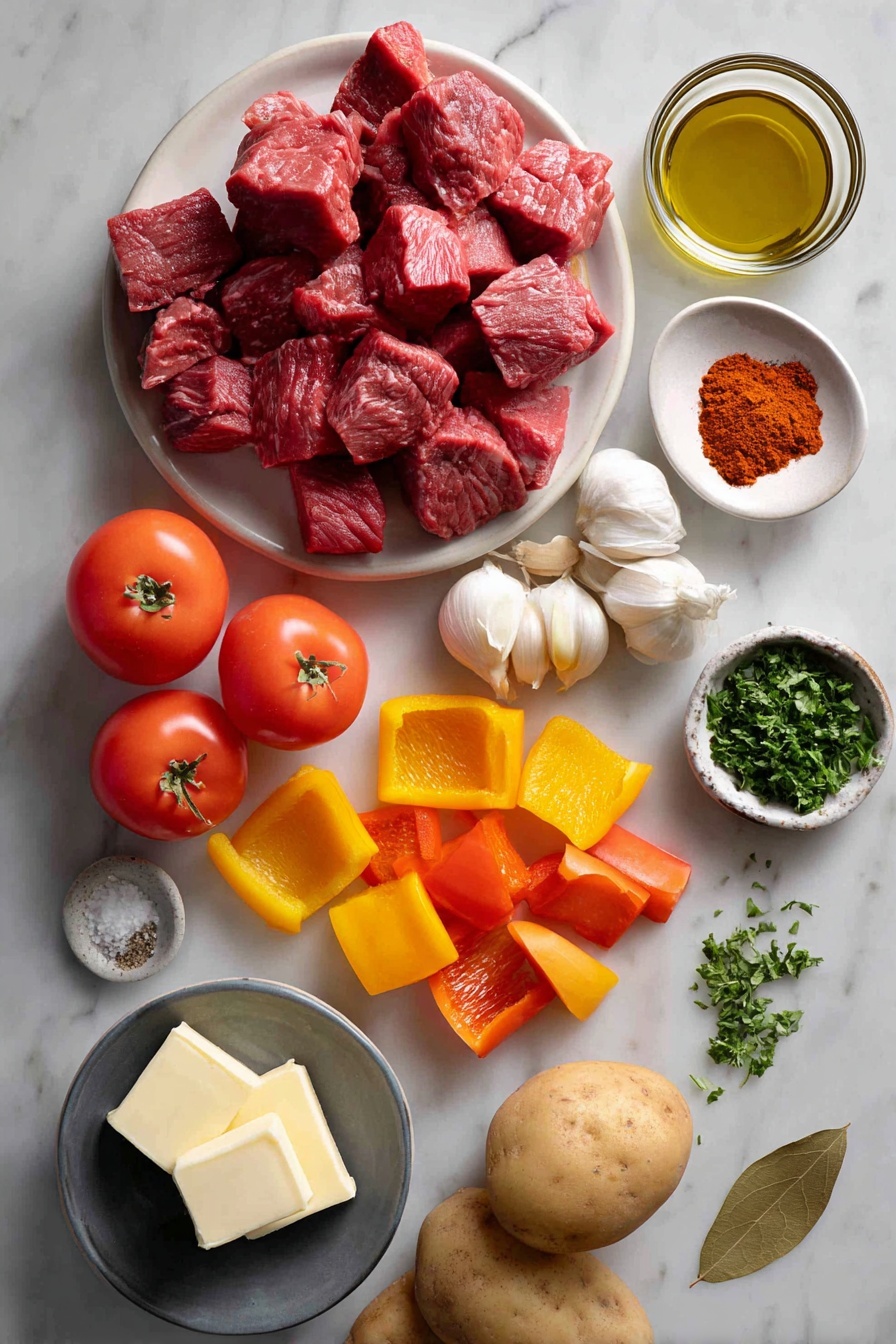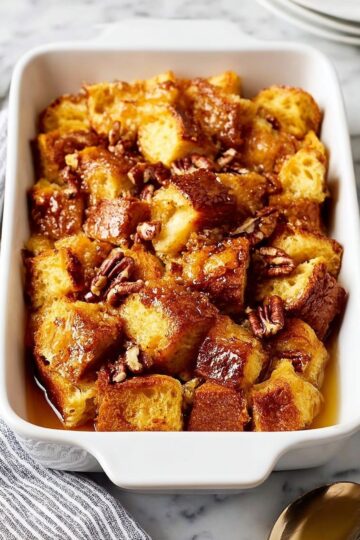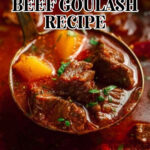There’s something truly magical about a warm, hearty stew that wraps you in comfort—**Classic Hungarian Beef Goulash Recipe** is exactly that kind of dish. With its rich paprika aroma and tender beef, it promises both flavor and coziness in every bite.
Jump to:
Why You'll Love This Recipe
I’ve made this Classic Hungarian Beef Goulash Recipe more times than I can count, and what keeps me coming back is how it strikes the perfect balance between simplicity and impressive flavor. It’s the kind of recipe you’ll want cozying up your dinner table on chilly nights.
- Deep, authentic flavor: The Hungarian paprika infuses the stew with a smoky, slightly sweet character that’s impossible to resist.
- Tender beef every time: Slow cooking breaks down the chuck into melt-in-your-mouth goodness.
- Easy to make: Just a single pot and straightforward steps make it perfectly approachable.
- Flexible and forgiving: Whether you use an oven, stove, or slow cooker, it turns out just right.

Ingredients & Why They Work
The magic of this Classic Hungarian Beef Goulash Recipe really comes down to the harmony between ingredients—robust beef, vibrant paprika, and fresh veggies create a stew that tastes both traditional and fresh. Here are the key ingredients and why they’re important to nail:

- Beef chuck: This cut has great marbling and connective tissue that melts into tender, flavorful chunks during slow cooking.
- Hungarian-style paprika: Using authentic paprika is a game-changer here; it’s smoother and less bitter than regular paprika, giving the goulash that classic taste.
- Brown onions: They caramelize beautifully, adding natural sweetness and depth to the stew base.
- Garlic: Provides an underlying warmth and savory punch without overpowering the other flavors.
- Bell peppers (capsicum): They bring a subtle sweetness and fresh crunch when just cooked through.
- Tomatoes: They help break down the stew’s richness and add a pleasant tangy note.
- Caraway seeds (optional): A traditional touch that adds a mild earthy, almost anise-like flavor that transports you to Central Europe.
- Bay leaf: Boosts the stew’s aromatic complexity in subtle ways.
- Beef stock: Low-sodium for control over salt while enhancing the stew’s depth.
- Carrots and potatoes: Classic stew veggies to balance texture and sweetness.
- Parsley (optional garnish): A fresh pop of color and brightness at the end.
Make It Your Way
I love tweaking this Classic Hungarian Beef Goulash Recipe depending on what I have on hand or the mood I’m in. Don’t be shy about making it your own — that’s part of the fun!
- Variation: Once, I swapped the traditional beef chuck for beef cheeks, and the stew became unbelievably silky and tender. If you prefer leaner meat, try brisket, but remember it cooks faster, so keep an eye on it.
- Vegetables: Feel free to toss in some parsnips or celery for more earthy notes, especially in fall and winter.
- Spice level: Traditional Hungarian goulash isn’t spicy hot, so skip hot paprika and rely on the sweetness of regular or Hungarian paprika for that deep color and flavor.
- Cooking method: I usually choose the oven method because I enjoy the caramelization on the meat edges, but if you’re busy, a slow cooker is a fantastic hands-off option.
Step-by-Step: How I Make Classic Hungarian Beef Goulash Recipe
Step 1: Season the Beef and Prepare the Base
First off, toss those beef chunks with half of your salt and black pepper. Seasoning at this stage gives the meat a solid flavor base. Then heat your olive oil and butter in a big, sturdy dutch oven. As soon as the butter melts, add your onions and cook them over high heat for about 6 minutes, until their edges just start turning golden. This is key for that savory sweetness I always look forward to in my goulash.
Step 2: Brown the Beef
Add the beef to your pot and stir well. Don’t worry if it doesn’t get a deep brown crust—that’s not what you’re after here. Just cook it until the outside changes from red to brown, about 2 minutes. This step locks in juices and adds subtle flavor for the slow cooking ahead.
Step 3: Add Veggies and Spice
Next up, stir in your minced garlic, capsicum, and tomatoes. Cook this for around 3 minutes so the tomatoes start breaking down nicely, adding body to the stew. Toss in your paprika, caraway seeds (if you’re using them), and bay leaf, stirring just for 30 seconds to release those beautiful aromas.
Step 4: Slow Cook to Tender Perfection
Pour in your beef stock, give the pot a good stir, and bring the whole thing to a gentle simmer. Cover with the lid and pop your dutch oven into a preheated 180°C/350°F oven for 1.5 hours. This slow cook helps the beef soften while developing those deep flavors.
Step 5: Add Potatoes and Carrots
After 1.5 hours, the beef should be tender but not quite falling apart. Stir in your carrots and potatoes, cover again, and return it to the oven for another 30 minutes. Check your beef—if it’s not yet “fall-apart” tender, give it extra time in 10-minute increments. Patience pays off here!
Step 6: Serve and Garnish
Ladle the goulash into bowls and sprinkle generously with fresh parsley if you like that extra pop of green freshness. It’s perfect just as it is, but I often set the table with crusty bread or cheesy breads on the side for perfect dunking.
Top Tip
From my many attempts making this Classic Hungarian Beef Goulash Recipe, here are my favorite tips that really make a difference:
- Use authentic Hungarian-style paprika: It transforms the stew; using regular paprika won’t quite give you that smoky, sweet depth.
- Don’t rush the slow cook: Patience here means tender beef and amazing flavor. Set your timer but check texture before calling it done.
- Get caramelization for extra flavor: The oven method is my go-to because it gives subtle browning on the beef and onions that you can’t get just on the stove top.
- Be gentle when stirring: You want to keep the beef chunks intact, so stir gently especially after adding the potatoes and carrots.
How to Serve Classic Hungarian Beef Goulash Recipe

Garnishes
I’m a huge fan of finishing with fresh parsley—its bright, herbal note lifts the hearty stew beautifully. Some like a dollop of sour cream for creaminess, but I keep it simple with just parsley and plenty of bread to soak up the sauce.
Side Dishes
Traditionally, I serve it with rustic Hungarian nokedli (small dumplings), but mashed potatoes or crusty bread work beautifully too. Roasted root vegetables on the side add even more comfort to the plate.
Creative Ways to Present
Once I’ve made this for a dinner party, I served the goulash in mini cast iron pots with a sprinkle of cheese melted on top under the broiler for a bubbly finish. It was a fun twist that made everything feel special and extra cozy!
Make Ahead and Storage
Storing Leftovers
I usually let the goulash cool to room temperature then store it in airtight containers in the fridge. It keeps perfectly for 4 to 5 days and honestly, tastes better the next day when the flavors have fully melded.
Freezing
This recipe freezes brilliantly. I portion it into freezer-safe containers and pop them in for up to three months. Thaw overnight in the fridge and it’s ready to gently reheat without losing any of that rich flavor.
Reheating
To reheat, I prefer warming on the stovetop over low heat, stirring occasionally to prevent sticking. Adding a splash of water or stock helps keep the stew saucy and delicious, just like fresh.
Frequently Asked Questions:
The best cut for Classic Hungarian Beef Goulash Recipe is beef chuck because it has good marbling and connective tissue that breaks down beautifully during slow cooking, making the meat very tender. Beef cheeks and osso bucco are also fantastic alternatives if you want an even richer texture.
Traditional Hungarian goulash isn’t spicy hot, so typically you should avoid hot paprika. However, if you want to add some heat, you can experiment by adding a pinch of cayenne or hot paprika, but be cautious to not overpower the natural sweet paprika flavor.
This Classic Hungarian Beef Goulash Recipe thickens naturally as it simmers, thanks to the breakdown of beef collagen and the reduced stock. If your sauce is too thin, you can simmer uncovered for a short time to reduce it, or mash some of the cooked potatoes into the sauce for natural thickening.
Yes! While the oven method is my favorite because of even heat and caramelization, you can absolutely cook the goulash on the stove over ultra-low heat. Just cover and stir occasionally to prevent sticking. Cook for 1.5 hours with the beef, then add the potatoes and carrots, cooking for an additional 30 minutes.
Final Thoughts
Classic Hungarian Beef Goulash Recipe is one of those recipes that invites warmth, comfort, and hearty satisfaction to your table every time. I truly believe it’s worth having in your cooking repertoire—not just for its amazing flavor but because it’s a dish that encourages slow cooking, cozy nights, and sharing with the people you love. Give it a try, and soon enough it might just become one of your favorite go-to dinners.
Print
Classic Hungarian Beef Goulash Recipe
- Prep Time: 15 minutes
- Cook Time: 2 hours 20 minutes
- Total Time: 2 hours 35 minutes
- Yield: 5 servings
- Category: Main Course
- Method: Baking
- Cuisine: Hungarian
- Diet: Halal
Description
Traditional Hungarian beef stew known as Goulash, featuring tender beef cubes slow-cooked with onions, garlic, bell peppers, tomatoes, paprika, and hearty vegetables like carrots and potatoes. This rich, flavorful dish is perfect for a comforting meal and can be made in the oven, stovetop, or slow cooker.
Ingredients
Meat and Seasoning
- 1 kg beef chuck, cut in 3.5cm cubes
- 1 ¾ teaspoon cooking salt / kosher salt
- 1 teaspoon black pepper
Fats and Oils
- 1 tablespoon extra virgin olive oil
- 2 tablespoon unsalted butter
Vegetables
- 2 brown onions, cut into 1cm squares
- 5 garlic cloves, finely minced
- 2 capsicums/bell peppers (1 red and 1 yellow), cut into 2 cm squares
- 2 tomatoes, cut into 8 wedges then halved
- 2 carrots, peeled, cut in quarters lengthwise then into 1cm pieces
- 2 potatoes, cut into 1.2cm cubes
Spices and Herbs
- ¼ cup Hungarian-style paprika
- 1 teaspoon caraway seeds, optional
- 1 bay leaf
- 1 tablespoon finely chopped parsley, optional garnish
Liquids
- 1 litre low-sodium beef stock/broth
Instructions
- Preheat Oven: Preheat your oven to 180°C/350°F (or 160°C fan). Alternatively, prepare your slow cooker or stovetop as needed.
- Season Beef: Toss the beef cubes with half of the salt and black pepper to evenly season the meat.
- Cook Onions: Heat the olive oil and melt the butter in a large oven-proof dutch oven over high heat. Add the onions and cook for 6 minutes until edges are lightly golden.
- Brown Beef: Add the seasoned beef to the pot. Stir continuously until the beef's outside changes from red to brown, about 2 minutes; don’t expect a deep golden crust.
- Add Vegetables: Stir in the minced garlic, bell peppers, and tomatoes. Cook for 3 minutes so the tomatoes start breaking down.
- Add Spices: Mix in the Hungarian-style paprika, caraway seeds (if using), and bay leaf. Stir for 30 seconds to release their flavors.
- Slow Cook Beef: Pour in the beef stock, stir to combine, and bring the mixture to a simmer. Cover with a lid and place the pot in the preheated oven. Cook for 1 hour and 30 minutes.
- Add Root Vegetables: Remove the pot from the oven. Stir in the carrots and potatoes. Cover again and return to the oven for another 30 minutes until the beef is fall-apart tender. If needed, continue cooking in 10-minute increments.
- Serve: Ladle the goulash into bowls, sprinkle with finely chopped parsley if desired, and serve immediately. Enjoy with bread on the side for dipping if you like.
Notes
- The beef chuck is ideal for this recipe, but beef osso bucco, beef cheeks, gravy beef, or brisket can also be used. Leaner cuts may result in less rich gravy.
- Hungarian or Hungarian-style paprika is preferred for its smooth and slightly sweet flavor; avoid hot paprika to prevent excessive spiciness.
- Caraway seeds are traditional in this dish and complement the paprika with a distinctive aroma, but they are optional.
- Oven cooking is preferred for flavor development through caramelization and ease, but stovetop and slow cooker methods work well too. For stovetop, use ultra low heat and stir occasionally to avoid burning; for slow cooker, cook 6 hours on low before adding vegetables and then 2 more hours.
- Goulash tastes even better the next day. Leftovers keep for 4 to 5 days refrigerated or can be frozen for up to 3 months.
Nutrition
- Serving Size: 1 serving
- Calories: 450 kcal
- Sugar: 7 g
- Sodium: 600 mg
- Fat: 20 g
- Saturated Fat: 7 g
- Unsaturated Fat: 11 g
- Trans Fat: 0 g
- Carbohydrates: 28 g
- Fiber: 5 g
- Protein: 38 g
- Cholesterol: 110 mg







Leave a Reply